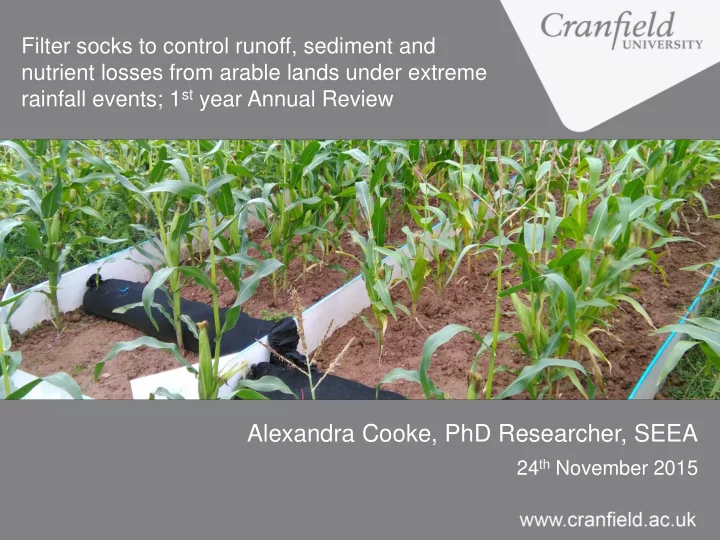

Filter socks to control runoff, sediment and nutrient losses from arable lands under extreme rainfall events; 1 st year Annual Review Alexandra Cooke, PhD Researcher, SEEA 24 th November 2015
Background – Soil Erosion Climate Soil Type Relief Management Practice Soil Erosion 2.2 million tonnes of topsoil lost annually (Graves et al, 2011) Off site impacts On site impacts Flooding Loss of SOM Biological activity Water holding capacity Crop productivity / Nutrient cycling Eutrophication yield
Background – Water Framework Directive (WFD) European Union WFD provides a method River Wye to ensure water quality in waterbodies catchment • Site of Special Scientific Interest (SSSI) • River Lugg part of the River Wye SAC UK • Failing WFD for sediment and phosphate • 30% failing • 27% ‘good ecological status’ River Lugg and Upper River lower River Agriculture - 70% Wye P target Wye P target of sediments, of 0.03 mg l -1 of 0.05 mg l -1 60% of nitrates and 25% of phosphates 70-85% sediment in River Wye and Lugg from eroded soils Climate change Target of <10 mg l -1 Impacts Impacts
Maize – High erosion risk crop Increase of maize in River Wye catchment Winter rainfall on bare soil leads to runoff and erosion Post-harvest maize stubble is left bare overwinter. Late harvest is often in wet soil conditions leading to Row crop nature of maize compaction and runoff concentrates water into channels.
The Project – Filter Socks (FS) 1. Concentrated flow or sheet flow 2. Slows runoff velocity Typically compost filled 3. Obstructions to flow, turbulence and friction increase 4. Sediment deposition To mitigate runoff, sediment and nutrient losses under current and extreme rainfall events River Lugg and River Clun catchments Phase 1 Phase 2 Phase 3
Project Hypothesis and Objectives Traditional filter socks can be combined with innovative P-sorbing fill media for use on arable land to reduce runoff volume and runoff rate, as well as losses of sediment, soluble-P and sediment-bound-P under a range of rainfall events 1. Critically evaluate the effectiveness of innovative P-sorbing filter sock fill media to facilitate sediment, sediment-bound and dissolved-P removal from surface water runoff. 2. Develop end-user guidelines to facilitate the adoption of filter socks as a practical BMP for the control of runoff, sediment and P-losses from agricultural land. 3. Carry out a cost-benefit analysis of the application of filter socks for the reduction of runoff, soil and P losses from agricultural land. 4. Investigate modelling approaches to identify optimum field placement (spacing) of filter socks to optimize runoff, sediment and P capture.
The Project – Phase 1 progress Phase 1 River Lugg catchment Fieldwork Challenges 1. Length of time to trial set-up – equipment and support issues Field trials 2. Extensive weed cover over plots - sampling 3. Lack of rainfall over summer months - sampling 4. Later than typical maize harvest – delaying overwinter trials 20 randomly distributed erosion plots 5. Communication issues with farmer • 4 x Control (no FS) • 4 x Compost FS • 4 x Bark FS • 4 x Compost + Nutriloxx FS • 4 x Bark + Nutriloxx FS
The Project – Phase 1 progress Literature Phase 1 review Field trials Phase 2 Maize Growers Association Rainfall Simulator survey and article Demonstration Day 25 th September 2015 IDF Curves PSM’s And IAgrE Landwards Relevant Results article • 95% of respondents had erosion issues • Combined erosion mitigation – cover cropping, changes to ploughing regime, and end-of-pipe solutions • Costs of filter socks main consideration • Preferred fill media – woodchip; compost with nutrient sorbing bacteria; compost with a seedbank; silica sand.
Next Steps Continued sampling until end of Phase 1 trials in April 2016 Field trials • Soil: pH, PSD, OM, Olsen-P, TOP; • Compost and bark: Olsen-P, TOP; Laboratory • Phase 1 Nutriloxx: PSD, pH, elemental analysis using SEM; analysis • Treatment Performance: Runoff sediment load and concentration, TOP, Olsen-P, hydrographs Statistics Analysis of deposition sequence Maize canopy analysis
Next Steps Phosphorus sorbing Literature review materials (PSMs) LandIs data 1. Bromyard / Barton series – Typical Lugg medium silty Soil types catchment soils 2. Escrick / Eardiston series – Phase 2 sandy loam / sandy silt loam Rainfall simulator Flood Estimation Handbook and IDF Curves for the Rainfall events Rational Method Lugg catchment LandIs data 1. 2 degrees Typical Lugg slope Slope gradients 2. 5 degrees gradients 3. 10 degrees 4. 15 degrees 5. 20 degrees
Next steps EUROSEM – European Soil Erosion Model Modelling AGNPS – Agricultural Non-Point Source Pollution Model Phase 2 BMP development and CBA Phase 3 September 2016 - Field River Clun trials catchment Phase 2 Rainfall simulator results
Thank you for listening!
Phosphorus sorbing materials (PSMs) PSMs as indicated by the literature Crushed Concrete Bituminous refuse ash Humate product Wollastonite Drinking water treatment residual Polonite Mg fertiliser by-product Filtra P Mg salts Kaolinite Organic soil Aluminium sulphate Gypsum Limestone Iron Ochre Dolomite Silica Sand Laterite Compost with bacteria Marl Emergent vegetation species and macrophytes Blast furnace slag
Recommend
More recommend